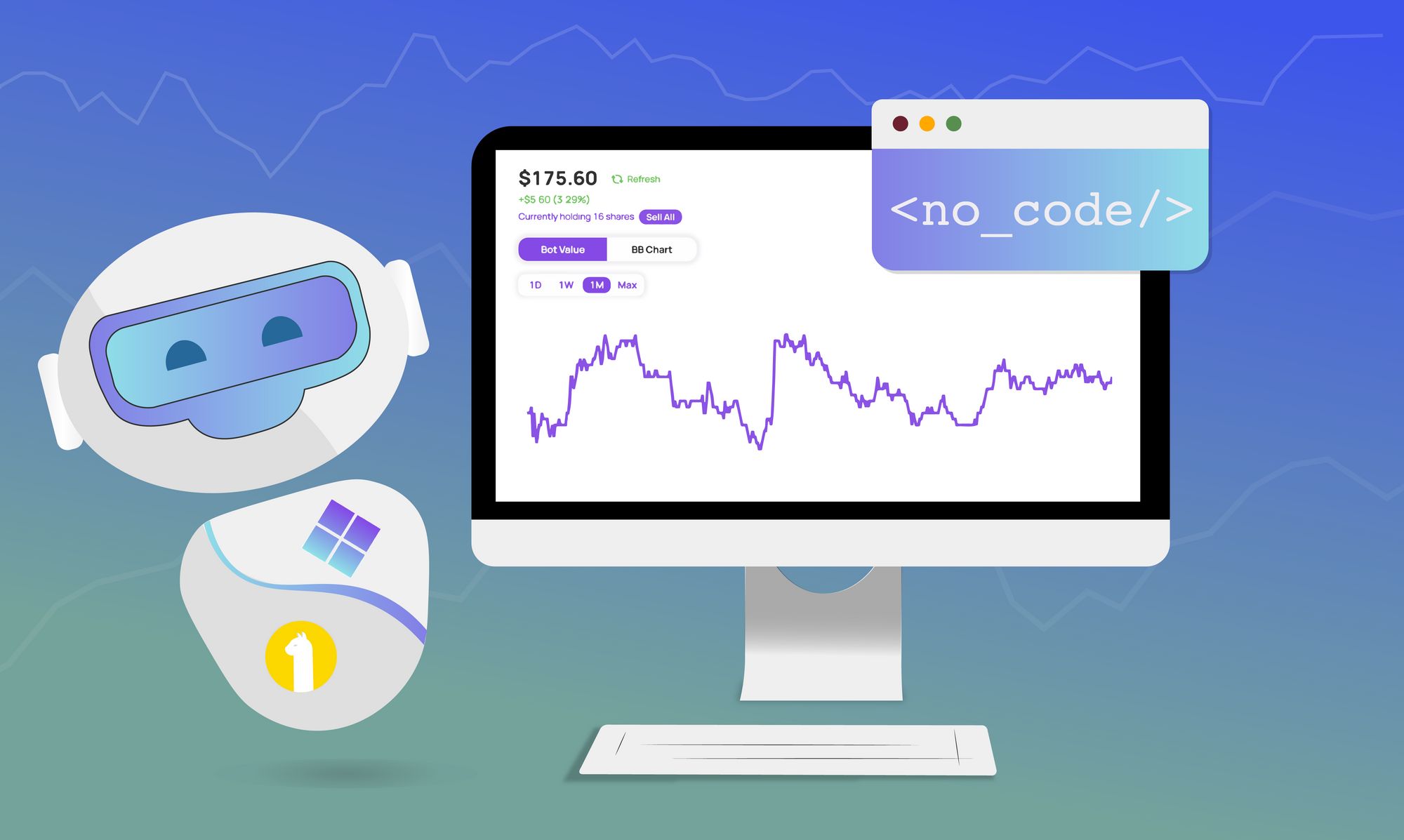Introduction
Welcome to the world of trading bots! In today’s fast-paced financial markets, investors are constantly on the lookout for new tools and strategies to gain a competitive edge. One such tool that has gained popularity in recent years is the trading bot.
A trading bot is a software application that automates the process of executing trades in the financial markets. It uses predefined algorithms and rules to analyze market data, identify trading opportunities, and execute trades on behalf of the user. This automated approach to trading offers several advantages, including speed, efficiency, and the ability to trade across multiple markets simultaneously.
The rise of trading bots can be attributed to advancements in technology, particularly in the fields of artificial intelligence and machine learning. These technologies have enabled the development of sophisticated algorithms that can quickly analyze vast amounts of data and make trading decisions in real-time.
Trading bots can be particularly beneficial for busy investors who do not have the time or expertise to actively trade in the markets. By automating the trading process, these bots can execute trades even when the user is not actively monitoring the markets. This allows investors to take advantage of trading opportunities 24/7, without being limited by their own availability.
However, it is important to note that trading bots are not a guaranteed path to financial success. Like any other investment strategy, they come with their own risks and limitations. It is crucial for users to understand how these bots work and the potential risks involved before implementing them in their trading strategies.
In this article, we will explore the world of trading bots in more detail. We will discuss how they work, the advantages they offer, the risks and limitations to be aware of, and the different types of trading bots available in the market. We will also provide tips on how to choose the right trading bot for your needs, as well as advice on setting up and maximizing the potential of a trading bot. So let’s dive in and explore the fascinating world of trading bots!
Definition of a Trading Bot
A trading bot, also known as an automated trading system or algorithmic trading software, is a software application that is designed to automatically execute trades in financial markets. It follows predefined rules and algorithms to analyze market data, identify trading signals, and place trades without the need for human intervention.
The primary objective of a trading bot is to automate the trading process and eliminate the need for manual execution of trades. By doing so, it aims to take advantage of market opportunities that may arise at any time, even when the user is not actively monitoring the markets.
Trading bots can be programmed to trade across various financial markets, including stocks, cryptocurrencies, forex, commodities, and more. They can execute trades based on a wide range of indicators, such as moving averages, trend lines, volume, and various technical analysis tools.
One of the key features of a trading bot is its ability to swiftly process large amounts of market data and make trading decisions in real-time. This is made possible through the integration of advanced technologies such as artificial intelligence, machine learning, and natural language processing. These technologies enable the bot to analyze market trends, track news and social media sentiment, and adapt its trading strategy accordingly.
Trading bots can be customized and tailored to meet the specific needs and preferences of individual traders. Users can define their desired trading parameters, risk tolerance, and investment goals, which the bot will then use to execute trades. Some trading bots also offer backtesting capabilities, allowing users to test their strategies using historical market data to evaluate their potential profitability.
It is important to note that while trading bots can be highly efficient and effective in executing trades, they are not infallible. They are still reliant on the quality and accuracy of the algorithms and rules they are programmed with. Additionally, market conditions can change rapidly, and unexpected events can impact the performance of trading bots. Therefore, it is crucial for users to continually monitor and evaluate the performance of their chosen trading bot to ensure optimal results.
How Trading Bots Work
Trading bots function based on a set of predefined rules and algorithms that determine when and how trades should be executed. These rules are created by traders and developers and are designed to take advantage of specific market conditions and trading strategies.
When it comes to executing trades, trading bots rely on two primary methods: signal-based trading and arbitrage trading.
Signal-based trading involves analyzing various technical indicators, such as moving averages, MACD, and RSI, to identify patterns or signals that indicate potential buy or sell opportunities. Trading bots continuously monitor price movements and market data in real-time to detect these signals. Once a signal is triggered, the bot will execute the trade automatically based on the predefined rules.
Arbitrage trading, on the other hand, involves taking advantage of price differences between different markets or exchanges. Trading bots monitor multiple exchanges simultaneously and identify price disparities that could lead to profitable trades. These bots can perform quick transactions to take advantage of these pricing discrepancies before they disappear.
In order to execute trades, trading bots need to be integrated with a trading platform or exchange. They communicate with the platform’s API (Application Programming Interface) to access market data, place orders, and manage trades. The speed and reliability of these API connections are crucial for the success of trading bots, as even a slight delay can impact the profitability of trades.
It’s important to note that the effectiveness and profitability of trading bots depend on the quality and accuracy of the algorithms and rules they are programmed with. Backtesting, which involves testing the trading strategy using historical data, is often done to evaluate the performance and optimize the algorithms before deploying the bot in live trading.
While trading bots offer the advantage of speed and automation, they are not immune to risks and limitations. Market volatility, unexpected events, and technical glitches can impact the bot’s performance. It is crucial for traders using trading bots to monitor their performance, adjust the algorithms if necessary, and stay updated on market conditions.
Advantages of Using Trading Bots
Trading bots offer several advantages to traders, making them an attractive option for both experienced and novice investors. Here are some key advantages of using trading bots:
- Automation and Efficiency: Trading bots automate the trading process, eliminating the need for manual execution of trades. This saves time and ensures that trades are executed promptly and efficiently, even in fast-moving markets.
- 24/7 Trading: Unlike human traders who have limits on their availability, trading bots can monitor the markets and execute trades 24 hours a day, seven days a week. They can take advantage of trading opportunities at any time, even when the user is asleep or unavailable.
- Speed and Accuracy: Trading bots can analyze vast amounts of market data and make trading decisions in a matter of milliseconds. This allows them to capitalize on price movements and execute trades at optimal prices, potentially leading to increased profitability.
- Elimination of Emotional Bias: Emotions can often cloud judgment and lead to irrational trading decisions. Trading bots, being free from emotions, strictly adhere to predefined rules and algorithms, reducing the impact of emotional biases on trading strategies.
- Backtesting and Strategy Optimization: Many trading bot platforms offer backtesting capabilities, allowing traders to test their strategies using historical market data. This helps in evaluating the performance of trading strategies and optimizing them before deploying the bot in live trading.
- Diversification: With the ability to trade across multiple markets and instruments simultaneously, trading bots enable diversification of trading strategies. This spreads the risk across different assets and can help mitigate losses in case of adverse market conditions.
It is important to note that while trading bots offer several advantages, they are not a magic formula for guaranteed profits. Trading carries inherent risks, and market conditions can change rapidly, impacting the performance of trading bots. It is essential to choose a reputable and reliable trading bot platform, set realistic expectations, and monitor the bot’s performance to ensure it aligns with your trading goals and risk tolerance.
Risks and Limitations of Trading Bots
While trading bots offer numerous benefits, it is crucial to understand and acknowledge the risks and limitations they entail. Here are some risks and limitations of using trading bots:
- Technical Issues: Trading bots rely on the stability and reliability of the trading platform and API connections. Technical glitches, system failures, or network disruptions can potentially lead to missed trades, delayed execution, or other undesired outcomes.
- Market Volatility: Rapid and unpredictable price fluctuations can have an adverse impact on trading bot performance. The algorithms that work well in stable market conditions may struggle to adapt to sudden volatility, leading to unexpected losses.
- Over-Optimization: While backtesting and strategy optimization are essential steps in fine-tuning trading bots, there is a risk of over-optimization. Over-optimizing a bot’s strategy based on historical data can lead to poor performance in real-time trading when market conditions differ from the backtesting period.
- Dependency on Historical Data: Trading bots typically rely on historical market data to identify patterns and make decisions. However, past performance does not guarantee future results, and market dynamics can change over time, rendering certain strategies less effective or obsolete.
- Lack of Human Judgment: Trading bots strictly follow predefined rules and algorithms, devoid of human judgment and intuition. While this eliminates emotional biases, it may also limit the ability to make contextual decisions based on current market conditions or unexpected events.
- Risk of Black Swan Events: Black swan events, such as major geopolitical events or financial crises, can have a significant impact on financial markets. Trading bots may not be equipped to handle such extreme events, potentially leading to substantial losses.
- Fraud and Hacking Risks: As trading bots require integration with trading platforms and exchanges, there is a risk of fraud or hacking. It is essential to choose reputable and secure trading bot platforms and take necessary measures to protect personal and financial information.
Despite these risks and limitations, trading bots can still be a valuable tool for traders. It is important to use them cautiously, continuously monitor their performance, and be prepared to make adjustments as necessary. A well-informed and prudent approach is crucial to maximize the potential benefits of trading bots and minimize the associated risks.
Different Types of Trading Bots
Trading bots come in different types, each designed to cater to specific trading strategies and market conditions. Here are some of the most common types of trading bots:
- Market Making Bots: Market making bots are designed to provide liquidity to the market by placing both buy and sell orders. These bots continuously place limit orders on both sides of the order book, profiting from the spread between the buy and sell prices.
- Trend Following Bots: Trend following bots monitor price trends and aim to capitalize on the continuation of established trends. They buy when the price is trending upwards and sell when the price trend reverses or shows signs of exhaustion. These bots employ various technical indicators to identify and follow market trends.
- Arbitrage Bots: Arbitrage bots exploit price discrepancies between different exchanges or markets. These bots simultaneously monitor multiple platforms and execute trades to profit from the price difference. They require fast execution and reliable connectivity to take advantage of the limited window of opportunity.
- Mean Reversion Bots: Mean reversion bots operate on the principle that prices tend to revert to their average or mean over time. These bots identify situations where the price has deviated significantly from its average and execute trades to capture potential profits as it returns to the mean.
- Scalping Bots: Scalping bots aim to profit from small price movements by quickly entering and exiting trades. These bots place numerous trades in a short period, relying on minimal price fluctuations to capture profits. Speed and low trading fees are crucial for the success of scalping bots.
- Sentiment Analysis Bots: Sentiment analysis bots analyze news, social media sentiment, and other forms of market sentiment to make trading decisions. These bots use natural language processing techniques to gauge market sentiment and adjust their strategies accordingly.
- Portfolio Management Bots: Portfolio management bots manage and rebalance investment portfolios based on predefined investment strategies or asset allocations. These bots automatically adjust the portfolio composition based on market conditions and keep the portfolio diversified and aligned with the user’s investment goals.
It is important for traders to choose a trading bot that aligns with their preferred trading strategy and risk tolerance. Some platforms offer customizable bots where users can define their own trading rules and algorithms, while others provide pre-built bots that can be used out of the box.
Understanding the different types of trading bots and their functionalities can help traders make informed decisions when choosing the most suitable bot for their trading needs.
Popular Trading Bot Platforms
There are numerous trading bot platforms available in the market, each offering unique features and functionalities. Here are some popular trading bot platforms:
- 1. 3Commas: 3Commas is a comprehensive trading platform that supports a wide range of exchanges. It offers a user-friendly interface and provides features such as smart trading, portfolio management, and social trading. 3Commas also offers a marketplace where users can access and purchase pre-built trading strategies.
- 2. HaasOnline: HaasOnline is a well-established trading bot platform that offers advanced trading features. It supports various exchanges and provides users with a range of trading bots, including market making bots, trend following bots, and scalping bots. HaasOnline also offers backtesting and customization options for more advanced users.
- 3. Gunbot: Gunbot is a popular trading bot platform known for its user-friendly interface and customizable trading strategies. It supports multiple exchanges and offers a wide range of trading indicators to help users optimize their trading strategies. Gunbot also provides backtesting capabilities to test and fine-tune strategies.
- 4. Cryptohopper: Cryptohopper is a cloud-based trading bot platform that offers a user-friendly interface and a wide range of features. It supports various exchanges and provides users with pre-built trading strategies. Cryptohopper also offers a marketplace where users can purchase additional trading strategies developed by other users.
- 5. Zenbot: Zenbot is an open-source trading bot platform that can be customized and modified by more technically inclined users. It supports multiple exchanges and provides a range of trading strategies, including trend following and mean reversion. Zenbot allows users to define their own trading rules and indicators.
- 6. BitMEX: BitMEX is a popular exchange that offers its own trading bot API. Traders can use the BitMEX API to connect their trading bots directly to the exchange for executing trades. BitMEX supports margin trading and offers advanced order types, making it a preferred choice for users looking to engage in leveraged trading.
It is important to research and compare different trading bot platforms to find the one that best suits your trading style, preferences, and budget. Factors to consider include ease of use, supported exchanges, available trading strategies, customization options, security features, and customer support.
Remember to exercise caution and thoroughly understand the functionalities and risks associated with each platform before integrating your trading bot and executing trades on live markets.
Choosing the Right Trading Bot for You
Choosing the right trading bot for your needs is crucial to ensure a successful and profitable trading experience. Here are some factors to consider when selecting a trading bot:
- Trading Strategy: Determine your trading strategy and goals before selecting a trading bot. Different bots are designed to execute specific trading strategies, such as market making, trend following, or arbitrage. Choose a bot that aligns with your preferred strategy and trading style.
- Supported Exchanges: Ensure that the trading bot supports the exchanges you want to trade on. Not all bots are compatible with every exchange, so checking for exchange compatibility is essential to ensure seamless integration and execution of trades.
- User Interface and Ease of Use: Consider the user interface and ease of use of the trading bot platform. A user-friendly interface with intuitive navigation and clear instructions can significantly enhance your trading experience, especially if you are a beginner.
- Security: Security should be a top priority when choosing a trading bot platform. Look for platforms that offer features like two-factor authentication (2FA), data encryption, and cold storage for funds. Research the platform’s reputation and check for any past security incidents.
- Customization and Flexibility: Determine the level of customization and flexibility you require. Some platforms offer customizable bots that allow you to define your own trading rules and strategies. Others provide pre-built bots that are ready to use out of the box.
- Backtesting and Historical Data: Consider if the trading bot platform offers backtesting capabilities. Backtesting allows you to test your trading strategy using historical data, giving you insights into its potential performance. Access to accurate historical data is crucial for evaluating and optimizing your strategy.
- Customer Support: Look for platforms that offer responsive and reliable customer support. In case you encounter any issues or have questions, having access to competent customer support can be invaluable.
- Pricing and Cost Structure: Evaluate the pricing and cost structure of the trading bot platform. Some platforms charge a one-time fee, while others have monthly or annual subscriptions. Consider the cost and ensure that it aligns with your budget and expected trading volume.
Take your time to research and compare different trading bot platforms based on these factors. Consider reading reviews, getting feedback from other traders, and even testing out the platforms with demo accounts if available. The right trading bot will depend on your individual preferences, trading goals, and level of experience.
Remember that choosing the right trading bot is only the first step. Continuous monitoring, evaluation, and adaptation of your trading bot’s performance and strategies are essential for long-term success in the ever-evolving financial markets.
How to Set Up and Use a Trading Bot
Setting up and using a trading bot involves several steps. Here is a general guide on how to set up and use a trading bot:
- Choose the Right Platform: Select a reputable trading bot platform that aligns with your trading needs and preferences. Consider factors such as supported exchanges, available trading strategies, user interface, and security features.
- Create an Account: Sign up for an account on the chosen trading bot platform. Provide the necessary information and go through any verification processes that may be required.
- Connect to an Exchange: Connect your trading bot to the exchange where you want to execute trades. Follow the platform’s instructions to establish the connection by entering the necessary API keys provided by the exchange.
- Select a Trading Strategy: Choose the trading strategy that best fits your goals and trading style. Some platforms provide pre-built strategies, while others allow for customization. Set the desired parameters, such as entry and exit points, stop-loss levels, and risk management rules.
- Backtesting and Optimization: If available, utilize the platform’s backtesting capabilities to test your trading strategy using historical market data. This step allows you to evaluate the strategy’s performance and make necessary optimizations.
- Start Small: When using a live trading bot, it is recommended to start with a small amount of capital. This allows you to observe the bot’s performance in real-time and make adjustments if needed while limiting potential risks.
- Monitor and Evaluate: Continuously monitor the performance of your trading bot. Keep an eye on key metrics such as profitability, win/loss ratio, and drawdown. Evaluate the bot’s performance periodically and make necessary adjustments to optimize results.
- Stay Informed: Stay updated with market news, events, and any changes that may impact your trading strategy. This allows you to adapt your trading bot’s settings in response to changing market conditions.
- Review and Adjust: Regularly review your trading bot’s performance and make adjustments as necessary. Consider adjusting parameters, adding or removing specific indicators, or exploring different trading strategies to optimize the bot’s effectiveness.
- Practice Risk Management: Implement proper risk management techniques when using a trading bot. Set realistic profit targets, use stop-loss orders to limit potential losses, and avoid trading with more capital than you can afford to lose.
- Stay Involved: While the trading bot automates the trading process, it is important to remain involved. Keep an eye on the bot’s activities, market conditions, and any significant changes that may require intervention or adjustment.
Note that the setup and usage processes may vary slightly depending on the trading bot platform you choose. Always refer to the platform’s documentation and user guides for specific instructions.
Remember that trading bots are tools, and proper understanding, monitoring, and adjustment are necessary for successful and profitable trading outcomes.
Tips for Maximizing the Potential of a Trading Bot
To maximize the potential of a trading bot and enhance your trading outcomes, consider the following tips:
- Choose the Right Timeframe: Select the appropriate timeframe for your trading strategy. Different timeframes can yield different trading signals and outcomes. Consider the characteristics of the market you are trading and align your bot’s strategy accordingly.
- Regularly Monitor Performance: Continuously monitor the performance of your trading bot. Keep track of key metrics such as profitability, win/loss ratio, and drawdown. Regularly reviewing the bot’s performance allows you to identify any potential issues or areas for improvement.
- Understand the Market Conditions: Stay informed about the current market conditions and news that may impact your trading bot’s performance. Being aware of market trends, economic events, and regulatory changes can help you make informed decisions about your bot’s strategy and settings.
- Implement Proper Risk Management: Practice effective risk management techniques when using a trading bot. Set appropriate stop-loss orders to limit potential losses in case of adverse market movements. Avoid allocating too much of your capital to a single trade or relying solely on the bot for all your trading decisions.
- Regularly Adjust and Optimize: Evaluate your trading bot’s performance regularly and make necessary adjustments. Consider tweaking trading parameters, adding or removing indicators, or exploring different strategies to optimize the bot’s effectiveness. Be mindful of over-optimization and strive for a balance between past performance and adaptability to current market conditions.
- Stay Disciplined: Stick to the predefined rules and strategies of your trading bot. Avoid making impulsive manual interventions based on emotions or short-term market fluctuations. Discipline and consistency are key to long-term success when using a trading bot.
- Stay Up to Date: Keep up with the latest developments in the field of automated trading. Stay informed about new features, updates, and improvements offered by your trading bot platform. Participate in relevant forums, communities, or social media groups to exchange insights and stay ahead of the curve.
- Consider Diversification: Diversify your trading strategies by using multiple bots or combining manual trading with automated trading. Different bots may perform better in different market conditions or for specific trading strategies. Diversification spreads the risk and can potentially enhance your overall trading outcomes.
- Don’t Rely Solely on the Bot: While trading bots can be powerful tools, it’s important not to solely rely on them. Keep yourself informed about market dynamics and seek to understand the reasoning behind your bot’s trading decisions. Combining your own knowledge and insights with the bot’s automation can lead to better decision-making.
- Continuous Learning and Improvement: Stay curious and continue learning about automated trading strategies and techniques. Explore new indicators, learn about different trading approaches, and stay adaptable to changes in the market. Continuous learning and improvement contribute to maximizing the potential of your trading bot.
Remember, trading bots are tools that require ongoing attention, evaluation, and adjustments to align with changing market conditions. Regular monitoring, risk management, and a proactive approach are essential for optimizing the potential of your trading bot and achieving long-term success.
Conclusion
Trading bots have revolutionized the way investors participate in financial markets. Their ability to automate trading processes, execute trades with speed and efficiency, and capitalize on market opportunities has attracted the attention of both novice and experienced traders. However, understanding the intricacies of trading bots and using them effectively is crucial for achieving success.
In this article, we explored the definition of trading bots and how they work. We discussed the advantages they offer, such as automation, 24/7 trading, speed, and elimination of emotional bias. We also dived into the risks and limitations associated with trading bots, including technical issues, market volatility, and dependency on historical data.
We highlighted the different types of trading bots available, ranging from market making and trend following bots to arbitrage and sentiment analysis bots. Additionally, we mentioned popular trading bot platforms such as 3Commas, HaasOnline, and Cryptohopper.
Choosing the right trading bot requires careful consideration of factors such as trading strategy, user interface, supported exchanges, customization options, and security features. Setting up and using a trading bot involves steps such as creating an account, connecting to an exchange, selecting a strategy, and regularly monitoring performance.
To maximize the potential of a trading bot, it is essential to stay informed, monitor performance, adjust and optimize strategies, implement effective risk management techniques, and remain disciplined. Continuous learning and improvement contribute to the long-term success of trading bot usage.
Trading bots are powerful tools, but they are not a one-size-fits-all solution. They require active involvement, market awareness, and ongoing evaluation to adapt to changing market conditions. With proper understanding, careful selection, and diligent monitoring, trading bots can enhance trading outcomes and provide traders with a competitive edge in today’s dynamic financial markets.

























